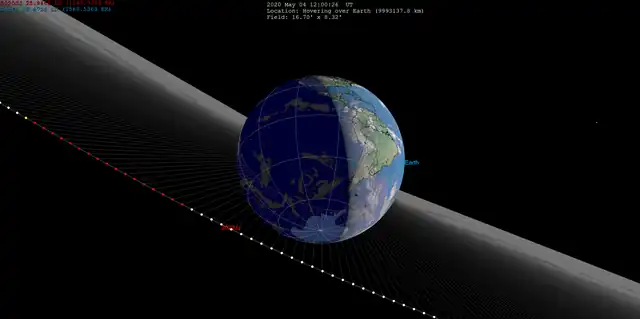 Orbit of 2020 JJ | |
| Discovery [1] | |
|---|---|
| Discovered by | Mt. Lemmon Survey |
| Discovery site | Mt. Lemmon Obs. |
| Discovery date | 4 May 2020 |
| Designations | |
| 2020 JJ | |
| Apollo · NEO | |
| Orbital characteristics [2] | |
| Epoch 31 May 2020 (JD 2459000.5) | |
| Uncertainty parameter 7 | |
| Observation arc | 0 day |
| Aphelion | 2.1425 AU |
| Perihelion | 0.8708 AU |
| 1.5067 AU | |
| Eccentricity | 0.4220 |
| 1.85 yr (675 d) | |
| 350.73° | |
| 0° 31m 58.44s / day | |
| Inclination | 11.192° |
| 44.188° | |
| 237.33° | |
| Earth MOID | 3.51662×10−6 AU (526 km)[2] |
| Physical characteristics | |
Mean diameter | 2.7–6 m[3] |
| 29.97±0.09[2] · 30.0[1] | |
2020 JJ is a tiny near-Earth asteroid of the Apollo group that passed 7,000 kilometres (4,300 mi) from the surface of Earth on 4 May 2020. It is estimated to be between 3 and 6 meters in diameter.[3]
Orbit and classification
2020 JJ orbits the Sun at a distance of 0.9–2.1 AU once every 1 years and 10 months (675 days; semi-major axis of 1.51 AU). Its orbit has an eccentricity of 0.42 and an inclination of 11° with respect to the ecliptic.[2]
Flyby
On 4 May 2020, it passed 7,000 km above the southern Pacific Ocean.[4] It was the closest since 2019 UN13 on 31 October 2019.[3]
 |
| 2020 JJ flyby with 1 minute markers, flying left to right. Red shows Earth's shadow. |
See also
References
- 1 2 "2020 JJ". Minor Planet Center. Retrieved 5 May 2020.
- 1 2 3 4 "JPL Small-Body Database Browser: (2020 JJ)" (2020-05-04 last obs.). Jet Propulsion Laboratory. Retrieved 5 May 2020.
- 1 2 3 Asteroid 2020 JJ flew past Earth at just 0.03 LD on May 4 -- the closest of the year and 6th closest on record 4 May 2020
- ↑ @tony873004 (May 4, 2020). "A few hours ago, newly-discovered asteroid C2QQFV2 passed only 7000 km above the South Pacific Ocean. It was in Ear…" (Tweet) – via Twitter.
External links
- 2020 JJ at AstDyS-2, Asteroids—Dynamic Site
- 2020 JJ at the JPL Small-Body Database
This article is issued from Wikipedia. The text is licensed under Creative Commons - Attribution - Sharealike. Additional terms may apply for the media files.


_on_Jul_14_2020_aligned_to_stars.jpg.webp)